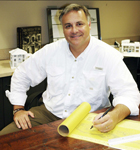1. Leverage experience to earn work
While technical aptitude plays a major role in the process of historical renovation, true finesse in the field is acquired by going beyond the books. Challenged by a changing job field in the early 1980s, Maas was inspired to jump headfirst into the preservation and conservation business. “We trained ourselves and started out by doing it on the weekends,” Maas says. “But it began to grow, and there is obviously a need for restoration, so it soon became a viable business.”
2. Gather historic data
“Because this is such a unique service, it’s important for us to have our team share a vision for how a restoration should go together,” Maas says. To return a period structure to its original appearance, the firm’s employees rely on their combined mastery of contemporary building codes and restoration standards, but they also conduct an exhaustive investigation of surrounding historical contexts. “You first need to do some research to understand the condition of a project prior to its reconstruction or deterioration,” Maas says. “Historic photos, documents, and [analysis of] unaltered areas help us determine the original aesthetic and what products we need to begin the restoration.”
In the case of the coke ovens, the firm learned that the town of Redstone was built as a product of western industrial expansion, and without the ovens, the place would not exist. The restoration of the ovens was therefore not only important in a general historical sense; it would also influence the legacy and future livelihood of Redstone. “The Redstone Historical Society had been trying to make this project happen for years,” Maas says.
3. Clean the project site
Water damage, resident wear, and routine neglect contributed to the poor condition of the coke ovens when BRS began. “[The site had] endured over 100 years of deterioration, stolen bricks, and use by campers and travelers,” Baker says. A historic commission in Redstone recognized the significance of the ovens and enthusiastically accepted BRS’s bid to repair the site, and immediately the firm set about clearing tons of garbage, brush, and overgrowth.

4. Excavate and expose the foundations
Some of the ovens had been filled with dirt over the years to prevent water infiltration and plant growth, but in order to successfully restore and stabilize them, BRS had to begin at the foundation of each one. “We worked alongside a general contractor and began to excavate in and around the ovens in order to remove all of the growth,” Baker says.
5. Remove and rebuild deteriorated sections
The project-engineering firm created a set of documents stating the existing condition of each oven and recommended repairs; this gave BRS a guideline to follow. “We had to remove all of the deteriorated brick in order to access the sound sections of the ovens and use that shape as a guide for building the ovens back up,” Baker says. Although the ovens are no longer being used for firing, BRS still had to find the appropriate firebrick material to authentically rebuild the old ovens. And, because of the beehive-style design of the structures, BRS had to cut the bricks by hand. “They used to ship the ovens in kits that only needed to be assembled, but because these particular kits are no longer available, we had to hand cut approximately 20,000 bricks,” Baker says. “In addition to the ovens we were restoring, we also built four new ovens to the same specifications as the old ones.


6. Plan for longevity
“We always do our projects with a long life expectancy in mind,” Maas says. “But a large part of that responsibility also rests on the stewards.” Because the ovens are still exposed to the elements, routine maintenance of the masonry is required to ensure structural longevity. As that continues, the artifacts are sure to reap rewards for the surrounding community. “The restored ovens have done wonders for Redstone commerce,” Maas says, “because now, instead of driving by, people stop, read, and learn.” ABQ


